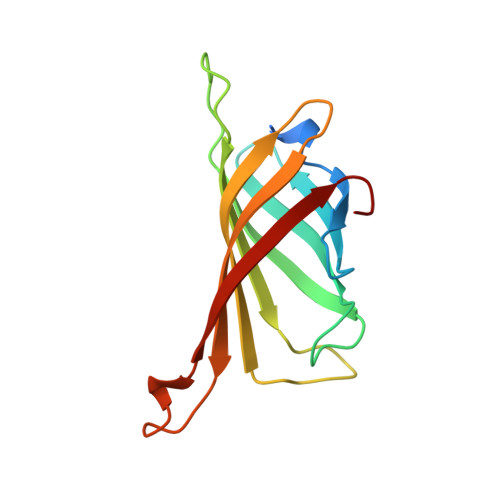Binding of biotin to streptavidin stabilizes intersubunit salt bridges between Asp61 and His87 at low pH.
Katz, B.A.(1997) J Mol Biology 274: 776-800
- PubMed: 9405158
- DOI: https://doi.org/10.1006/jmbi.1997.1444
- Primary Citation of Related Structures:
2IZA, 2IZB, 2IZC, 2IZD, 2IZE, 2IZF, 2IZG, 2IZH, 2IZI, 2IZJ, 2IZK, 2IZL, 2RTA, 2RTB, 2RTC, 2RTD, 2RTE, 2RTF, 2RTG, 2RTH, 2RTI, 2RTJ, 2RTK, 2RTL, 2RTM, 2RTN, 2RTO, 2RTP, 2RTQ, 2RTR - PubMed Abstract:
The remarkable stability of the streptavidin tetramer towards subunit dissociation becomes even greater upon binding of biotin. At two equivalent extensive monomer-monomer interfaces, monomers tightly associate into dimers that in turn associate into the tetramer at a less extensive dimer-dimer interface. To probe the structural basis for the enhancement of the stability of streptavidin by biotin, the crystal structures of apostreptavidin and its complexes with biotin and other small molecule and cyclic peptide ligands were determined and compared at resolutions as high as 1.36 A over a range of pH values from as low as 1.39. At low pH dramatic changes occur in the conformation and intersubunit hydrogen bonds involving the loop comprising Asp61 to Ser69. The hydrogen-bonded salt bridge between Asp61 Odelta2 and His87 Ndelta1, observed at higher pH, is replaced with a strong hydrogen bond between Asp61 Odelta1 and Asn85 Odelta1. Through crystallography at multiple pH values, the pH where this conformational change occurs, and thus the pKa of Asp61, was determined in crystals of space group I222 and/or I4122 of apostreptavidin and complexes. A range in pKa values for Asp61 was observed in these structures, the lowest being 1.78+/-0.19 for I222 streptavidin-biotin in 2.9 M (NH4)2SO4. At low pH the decrease in pKa of Asp61 and preservation of the intersubunit Asp61 Odelta2-Ndelta1 His87 hydrogen-bonded salt bridge in streptavidin-biotin versus apostreptavidin or streptavidin-peptide complexes is associated with an ordering of the flexible flap comprising residues Ala46 to Glu51, that in turn orders the Arg84 side-chain of a neighboring loop through resulting hydrogen bonds. Ordering of Arg84 in close proximity to the strong intersubunit interface appears to stabilize the conformation associated with the Asp61 Odelta2-Ndelta1 His87 hydrogen-bonded salt bridge. Thus, in addition to the established role of biotin in tetramer stabilization by direct mediation of intersubunit interactions at the weak interface through contact with Trp120, biotin may enhance tetramer stability at the strong interface more indirectly by ordering loop residues.
- Arris Pharmaceutical Corporation, 385 Oyster Point Boulevard, South San Francisco, CA 94080, USA.
Organizational Affiliation:


















